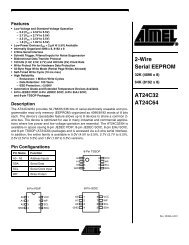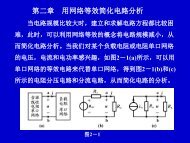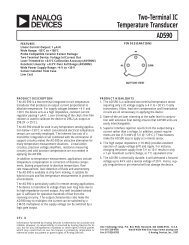AN INVARIANCE PRINCIPLE IN THE THEORY OF STABILITY
AN INVARIANCE PRINCIPLE IN THE THEORY OF STABILITY
AN INVARIANCE PRINCIPLE IN THE THEORY OF STABILITY
You also want an ePaper? Increase the reach of your titles
YUMPU automatically turns print PDFs into web optimized ePapers that Google loves.
I<br />
TECHNICAL<br />
REPORT 66-1<br />
r * '<br />
I<br />
J. P. LaSALLE<br />
<strong>AN</strong> <strong>IN</strong>VARI<strong>AN</strong>CE <strong>PR<strong>IN</strong>CIPLE</strong> <strong>IN</strong> <strong>THE</strong><br />
<strong>THE</strong>ORY <strong>OF</strong> <strong>STABILITY</strong><br />
APRIL, 1968<br />
ff 653 July 66<br />
CENTER FOR DYNAMICAL SYSTEMS<br />
(CODE)
<strong>AN</strong> <strong>IN</strong>VARI<strong>AN</strong>CE <strong>PR<strong>IN</strong>CIPLE</strong> <strong>IN</strong> TKE <strong>THE</strong>ORY <strong>OF</strong> <strong>STABILITY</strong><br />
J. P. LaSalle<br />
'<br />
Center for Dynamical Systems<br />
I Brown University<br />
1. Introduction.<br />
The purpose of this paper is to give a unified presentation<br />
of Liapunov's theory of stability that includes the classical<br />
Liapunov theorems on stability and instability as well as their<br />
more recent extensions.<br />
beginnings some time ago.<br />
The idea being exploited here had its<br />
It was, however, the use made of this<br />
idea by Yoshizawa in [l] in his study of nonautonomous differential<br />
equations and by Hale in [2] in his study of autonomous functional<br />
differential equations that caused the author to return to this<br />
subject and to adopt the general approach and point of view of this<br />
paper.<br />
This produces some new results for dynamical systems defined<br />
by ordinary differential equations which demonstrate the essential<br />
nature of a Liapunov function and which may be useful in applications.<br />
Of<br />
greater importance, however, is the possibility, as already in-<br />
dicated by Hale's results for functional differential equations,<br />
*This research was supported in part by the Nationalperonautics and<br />
Space Administration under- Grant No. NGR-40-002-015.hd under--Contract<br />
No, Ms8-11264,' in part by the Uniced States Air Force through the<br />
Air Force Office of Scientific Research underAGrant No AF-AFOSR-~~~~~~, /<br />
and in part by the United States Army Research OfficejDurham, under<br />
Contract No DA-31-124-ARO-D-270. -,- 1<br />
i
that these ideas can be extended to more general classes of dynam-<br />
2<br />
ical systems.<br />
It is hoped, for instance, that it may be possible<br />
to do this for some special types of dynamicalsystems defined by<br />
partial differential equations.<br />
In section 2 we present some basic results for ordinary<br />
differential equations.<br />
Theorem 1 is a fundamental stability<br />
theorem for nonautonomous systems and is a modified version of<br />
Yoshizawa's Theorem 6 in [l]. A simple example shows that the<br />
conclusion of this theorem is the best possible.<br />
However, when-<br />
ever the limit sets of solutions are known to have an invariance<br />
property then sharper results can be obtained.<br />
principle" explains the title of this paper.<br />
This "invariance<br />
It had its origin for<br />
autonomous and periodic systems in [3] - [SI, although we present<br />
here improved versions of those results.<br />
Miller in [6] has estab-<br />
lished an invariance property for almost periodic systems and ob-<br />
tains thereby a similar stability theorem for almost periodic<br />
systems.<br />
Since little attention has been paid to theorems which<br />
make possible estimates of regions of attraction (regions of asymptotic<br />
stability) for nonautonomous systems results of this type are<br />
included. Section 3 is devoted to a brief discussion of some of<br />
Hale's recent results [2] for autonomous functional differential<br />
equations.<br />
2. Ordinary differential equations.<br />
Consider the system
3<br />
n+ 1<br />
where x is an n-vector, f is a continuous function on R<br />
n<br />
to R and satisfies any one of the conditions guaranteeing unique-<br />
'ness of solutions. For each x in Rn we define 1x1 =<br />
2 23<br />
, and for E a closed set in Rn we define<br />
(xl + ... + xn)<br />
d(x,E) = Min [ Ix-yl : y in E).<br />
,<br />
Since we do not wish to confine our-<br />
selves to bounded solutions, we introduce the point at<br />
m<br />
and<br />
define d(x,m) = 1xl-l . Thus when we write E* = E U[m),<br />
we shall<br />
mean d(x,E*) = Min{d(x,E), d(x,m)), If x(t) is a solution of<br />
(l), we say that x(t) approaches E as t -+m if d(x(t),E) 4 9<br />
as t --$a. If we can find such a set E,<br />
we have obtained in-<br />
formation about the asymptotic behavior of x(t) as t + 00. The<br />
best that we could hope to do is to find the smallest closed set<br />
R that x(t) approaches as t -00. This set R is called the<br />
--<br />
positive limit set of x(t) and the points p in R are called<br />
the positive limit points of x(t). In exactly the same way one<br />
defines x(t) +E<br />
as t --f -= , negative limit sets, and negative<br />
limit points. This is exactly G. D. Birkhoff's concept of limit<br />
sets. A point p is a positive limit point of x(t) if and only<br />
if there is a sequence of times tn approaching 00 as n -+a and<br />
such that x(tn) + p<br />
as n 4 o . In the above it may be that the<br />
maximal interval of definition of x(t) is [3,~). This causes<br />
no difficulty since in the results to be presented here we need<br />
only with respect to time t replace mby T.<br />
We usually ignore
this possibility and speak as though our solutions are def'irred on<br />
[o,w) or (-m,m) .<br />
i<br />
n<br />
Let V(t,x) be a C fanction Oil [O,m) x R to R, and<br />
let G be my set in Rn . We shall say that V is a Liapunov<br />
function on G for equation (1) if V(t,x) 2 0 ana. V(t,x) 5<br />
-W(x) 5 0 for all t > 0 and all x in G where W is<br />
continuous on Rii to R a d<br />
We define (c is the closure of G)<br />
-<br />
E = (x, W(x) = 0, x in G).<br />
The following result is then a modified but closely re-<br />
lated version of Yoshizawa's Theorem 6 in [l].<br />
<strong>THE</strong>OREM 1. If V is a Liapunov function on G for equation (l),<br />
then each solution x(t) of (1) that remains in G for all<br />
t > to 2 0 approaches E* = EU (a] as t +co , provided one of<br />
the following conditions is satisfied:<br />
(i) For each p in there is a neighborhood 1\s of<br />
p such that If(t,x)l is bounded for all t > 0 and<br />
ail x in N.<br />
(ti) W is C1 and is bounded from above or below<br />
along each solution which remains in G<br />
t > to20.<br />
for all<br />
4<br />
1<br />
I<br />
t<br />
a<br />
I<br />
I<br />
I<br />
I<br />
I<br />
1<br />
I<br />
I<br />
I<br />
1<br />
c<br />
I<br />
I<br />
I<br />
I
5<br />
If E<br />
is bounded, then<br />
each solution<br />
of<br />
(1) that remains in G<br />
for t > t 2 0 either<br />
0<br />
approaches E<br />
Thus this theorem explains<br />
or 03<br />
as t+-.<br />
precisely the nature of the<br />
information given by a Liapunov function.<br />
A Liapunov function<br />
relative to a set G defines a set E which under the conditions<br />
of the theorem contains (locates) all the positive limit sets of<br />
P<br />
!<br />
1<br />
1<br />
I<br />
I<br />
I<br />
I<br />
I<br />
solutioils which for positive time remain in<br />
applying the result is to find "good" Liapunov functions.<br />
instance, the zero function V= 0<br />
G. The problem in<br />
is a Liapunov function for tiie<br />
whole space Rn aiid condition (ii) is satisfied but gives no inn<br />
information since E = R . It is trivial but useful for appli-<br />
cations to note that if V, and V, are Liapunov functions on G,<br />
I L<br />
then V = V + V2 is also a Liapunov function and E = E ll E2 .<br />
1<br />
1<br />
If E<br />
is smaller<br />
Liapunov function<br />
"good" as either of the two.<br />
by Yoshizawa.<br />
thm either El or E2 , -then V<br />
For<br />
is a "better"<br />
than either E or E2 and is always at least as<br />
1<br />
Condition (5) of Theorem 1 is essentially the one used<br />
We now look at a simple example where condition (ii)<br />
is satisfied and condition (i) is not.<br />
the conclusion of the theorem is the best possible.<br />
The example also shows that<br />
Consider<br />
*2 + p(t)? + x = 0 where p(t) 2 6 > 0 . Define 2V = x 2 + y 2 ,<br />
2 2<br />
where y = 2 . Then V = -p(t)y 6 - 6y and V is a Liapunov<br />
2 2<br />
function on R2 Now W = 6y and = 2 6 = ~ -2S(xy + p(t)) )<br />
-26xy. Since all solutions are evidently bounded for all t > 0,
6<br />
condition (ii) is satisfied. Here E is the x-axis (y = 0)<br />
and for each solution x(t), y(t) = 2(t) + 5<br />
that the equation<br />
t<br />
x + (2 + e )S + x = 0 has a solution<br />
as t + . Noting<br />
x(t) = 1 t e-t , we see that this is the best possible result without<br />
further restrictions on p .<br />
In order to use Theorem 1 there must be some means of<br />
determinLng which SolEtiOiis remain in G . The following corollary,<br />
which is an obvious consequence of Theorem 1, gives one way of<br />
doing this and also provides for nonautonomous systems a method for<br />
estimating regions of attraction.<br />
Corollary 1. Assume that there exist continuous functions u(x)<br />
n<br />
and v(x) on R to R such that U(X) 5 V(t,x) 5 V(X) for all<br />
t 2 0 .<br />
of<br />
4-<br />
Qrl<br />
+ +<br />
Define Q7 = {x ; U(X) < v} and let G be a component<br />
Let G denote the component of Q = {x ; v(x) < 71<br />
11<br />
containing G+ . If V is a Liapunov f’Jnction on G for (1) and<br />
the conditions of Theorem 1<br />
are satisfied, then each solution of<br />
(1) starting in G+ at any time t 2 o remains in G for all<br />
t > to and approaches E* as t + w e If G is bounded and<br />
Eo = r G C G+ , then Eo is an attractor and G is in its<br />
region of attraction.<br />
In general we know that if x(t) is a solution of<br />
0<br />
+<br />
(l)--in fact, if x(t> is any continuous function on R<br />
to R”--<br />
then its positive limit set is closed and connected.<br />
If x(t) is<br />
bounded, then its positive limit set is compact.<br />
There are, how-
1<br />
I<br />
I<br />
I<br />
I<br />
I<br />
ever, special classes of differential equations where the limit<br />
sets of solutions have an additional invariance property which<br />
makes possible a refinement ot' Theore= 1. me first of these are<br />
the autonomous systems<br />
a = f(x) (3)<br />
The limit sets of solutions of (3) are invariant sets. If x(t)<br />
is defined on [O,m) and if p is a positive limit point of x(t),<br />
7<br />
then the points on the solution through p on its maximal interval<br />
of definition are positive limit points of x(t). If x(t) is<br />
boEded for t > 0 , then it is defined un [O,mj,<br />
its positive<br />
limit set R is compact, noneinpty and solutions through points<br />
p of R are defined on (-a,..) (ioe., R is invariant). If<br />
the maximal domain of definition of<br />
x(t) for t > 0 is finite,<br />
then x(t) has no finite positive limit points:<br />
that is, if the<br />
maxirrlal ijnierval of definilion of x(t) for L > 0 is [O,p),<br />
I<br />
I<br />
I<br />
1<br />
I<br />
I<br />
1<br />
then x(t) + a as t -+p . As we have said before, we will always<br />
speak as though our solutions are defined on<br />
(-m,m)<br />
and it should<br />
be remembered that finite escape time is always a possibility unless<br />
there is, as for example in Corollary 2 below, some condition that<br />
rules it out. In Corollary 3 below, the solutions might well go to<br />
infinitjr iii finite time.<br />
The invariance property of the limit sets of solutions<br />
of autonomous systems (3) now ena5les us to refine Theorem 1.<br />
n<br />
Let V be a C1 function on R to R . If G is any arbitrary
set in Rn , we say that V is a Liapunov function on G for<br />
equation (3) if fl = (grad V). f does not change sign on G .<br />
-<br />
Define E = ( x ; i(x) = 3 , x ir, G 1 , where G is ihe<br />
closure of G . Let M be the largest invariant set in E . M<br />
will be a closed set.<br />
autonomous systems is then the following:<br />
-<br />
The fundamental stability theorem for<br />
<strong>THE</strong>ORFM 2. If V is a Liapunov function on G for (3), then<br />
each solution x(t) of (3) that remains in G for all t > 0<br />
(t < 0) approaches M* = M U (m) as t -+ m (t -m). If M is<br />
bounded, then either x(t) -+M or x(t) +m as t -+m (t -m) .<br />
This one theorem contains all of the usual Liapunov like<br />
theorems on stability and instability of autonomous systems. Here<br />
however, there are no conditions of definiteness for V or V ,<br />
and it is often possible to obtain stabilitjr information about a<br />
system witii these more general types of Liapunov functions.<br />
first corollary below is a stability result which for applications<br />
has been quite useful aid the second illustrates how one obtains<br />
infomatton on instability.<br />
v<br />
Cetaev's instability theorem is<br />
similarly an immediate consequence of Theorem 2 (see section 3).<br />
COROLLARY 2. Let G be a component of Q = ( x ; V(x) < 7 ) .<br />
0 -<br />
Ass-me tliai G is bon-ided, V 6 0 on G , and M = M n G c G .<br />
0<br />
Then M is an attractor and G is in its region of attraction.<br />
If, in addition, V is constant on the boundary of Mo , then<br />
7<br />
The<br />
8<br />
1<br />
1<br />
1<br />
I<br />
I<br />
I<br />
1<br />
I<br />
I<br />
I<br />
1<br />
I<br />
I<br />
1<br />
I<br />
1<br />
1<br />
I<br />
I
9<br />
Mo is a stable attractor.<br />
Note that if Mo consists of a single point p ,<br />
then p is asymptotically stable and G provides an estimate of<br />
its region of asymptotic stability.<br />
COROLLARY 3. Assume that relative to (3) that V > 0 on G<br />
and on the boundary of G that V = 0 . Then each solution of<br />
(3) starting in G approaches m as t -+ m (or possibly in<br />
finite time).<br />
There are also some special classes of nonautonomous<br />
systems where the limit sets of solutions have an invariance<br />
property. The simplest of these are periodic systems (see [3]).<br />
2 = f(t,x) , f (t + T,x) = f(t) for all t and x . (4)<br />
Eere in order to avoid introducing the concept of a periodic<br />
approach of a solution of (4) to a set and the concept of a<br />
periodic limit point let us confine ourselves to solutions<br />
x(t)<br />
of (4) which are bounded for t > 0 . Let R be the positive<br />
limit set of such a solution x(t), and let p be a point in R .<br />
Then there is a solution of (4) starting at p which remains in<br />
R for all t in (-w,oo) ; that is, if one starts at p at the<br />
proper time the solution remains in R for all time. Tnis is the<br />
sense now in which R is an invariant set. Let V(t,x) be C1<br />
on R x Rn and periodic in t of period T . For an arbitrary<br />
set G of Rn we say that V is a Liapunov function - on G<br />
for
10<br />
for the geriodic system (4) if V does not change sign for all<br />
t and all x in G . Define E = { (t,x); V(t,x) = 0, x in 3 }<br />
and let M be the union of all solutions x(t) of (4) with the<br />
property that (t,x(t)) is in E for all t . M could be called<br />
"the largest invariant set relative to E".<br />
One then obtains the<br />
following version of Theorem 2 for periodic systems:<br />
<strong>THE</strong><strong>OF</strong>EM 3. If V is a Liapunov function on G for the periodic<br />
system (4), then each solution of (4) that is bounded and remains<br />
In G for all t > 0 (t < 0) approaches M as t -+ 00 (t + -0~).<br />
In [6] Miller showed that the limit sets of solutions<br />
of almost periodic systems have a similar invariance property and<br />
from this he obtains a result quite like Theorem 3 for almost<br />
periodic systems.<br />
This then yields for periodic and almost periodic<br />
systems a whole chain of theorems on stability and instability<br />
quite similar to that for autonomous systems. For example, one has<br />
+<br />
Let Qrl = { x; V(t,x) < 7, all t in [O,T] } , and<br />
+ +<br />
COKOLLARY 4.<br />
let G be a component of Q . Let G be the compofient of<br />
11<br />
Q = { x; V(t,x) < 11 for some t in [O,T] } containing G+ . If G<br />
7<br />
is bounded, V 5 0 for all t and all x in G , and if M =<br />
M fl G C G+, then Mo is an attractor and G is in its region of<br />
attractioc. If V(t,x) = q(t) for all t and all x on the<br />
+<br />
0<br />
boundary of Mo<br />
, then Mo is a stable attractor.<br />
Our last example of an invariance principle for ordinary
11<br />
differential equations is that due to Yoshizawa in [l] for "asymptotically<br />
autonomous" systems. It is a consequence of Theorem 1<br />
and results by Markus and Opial (see [l] for references) on the<br />
limit sets of such systems. A system of the form<br />
is said to be asymptotically autonomous if (i) g(t,x) -+9 as<br />
t -+w uniformly for x in an arbitrary compact set of Rn ,<br />
(ii) J Ih(t,q(t))l dt < w Yor all cp bounded and continuous<br />
on [O,w)<br />
W<br />
0<br />
to Rn . The combined results of Markus and Opial then<br />
state that the positive limit sets of solutions of (3) are in-<br />
variant sets of k = F(x) . Using this, Yoshizawa then improved<br />
Theorem 1 for asymptotically autonomous systems.<br />
It turns out to be useful, as we shall illustrate in a<br />
moment on the simplest possible example, in studying systems (1)<br />
which are not necessarily asymptotically autonomous to state the<br />
theorem in the following manner:<br />
<strong>THE</strong>OREM 4.<br />
If, in addition to the conditions of Theorem 1, it is<br />
known that a solution x(t) of (1) remains in G for t > 0<br />
and is also a solution of an asymptotically autonomous system (?),<br />
then x(t) approaches M* = M U {OD) as t + w , where M is the<br />
largest invariant set of 2 = F(x) in E .<br />
It can happen that the system (1) is itself asymptotically<br />
autonomous in which case the above theorem can be applied. However,
..-<br />
Aid<br />
as the following example illustrates, the original system may not<br />
itself be asymptotically autonomous but it still may be possible<br />
to construct for each solution of (1) an asymptotically autonomous<br />
system (7) which it also satisfies.<br />
Consider again the example<br />
?= y (6)<br />
y=-x- P (t)Y , o < s ~ p ( t ) ~ m<br />
Now we have the additional assumption that<br />
for all t > 0<br />
p(t)<br />
is bounded from<br />
above. Let (x(t),<br />
-<br />
y(t)) be any solution of (6). As was argued<br />
previously below Theorem 1, all solutions are bounded and y(t) + 0<br />
as t + Q) .<br />
Now (E(t), y(t)) satisfies k = y , y =<br />
-x - p(t)y(t), and this system is asymptotically autonomous to<br />
(")<br />
E<br />
2= y, $= -x . With the same Liapunov function as before,<br />
is the x-axis and the largest invariant set of (*) in E is the<br />
origin.<br />
Thus for (6) the origin is asymptotically stable in the<br />
large<br />
3. Autonomous functional differential equation.<br />
Difference differential equations of the form<br />
2(t) = f(t,x(t),x(t-r)) 9 r > O (7)<br />
have been studied almost as long as ordinary differential equations<br />
and these as well as other types of systems are of the general form
where x is iri Rn and x is the function defined on [-r,O]<br />
t<br />
by x (2) = x(t+.r), -r S 2 6 0. Thus xt is the function that<br />
t<br />
describes the past history of the system on the interval [t-r,t]<br />
13<br />
and in order to consider it as an element in the space C<br />
of<br />
contizuous fmc-tions all defined on the same interval [-r,O], x,<br />
is taken to be the function whose graph is the translation of the<br />
graph of x on the interval [t-r,t] to the interval [-r,O] .<br />
Since such equations have had a long history it seems surprising<br />
that; it is only within the last 10 years or so that the geometric<br />
theory of ordinary differential equations has been successfully<br />
b<br />
carried over to functional differential equations.<br />
Krasovskii [8]<br />
has demonstrated the effectiveness of a geometric approach in ex-<br />
tending the classical Liapunov theory, including the converse<br />
theorems, to functional differential equations.<br />
An account of other<br />
aspects of their theory which have yielded to this geometric approach<br />
can be found in the paper [g] by Hale.<br />
What we<br />
wish to do here is<br />
to present Hale's extension in [2] of the results of Section 2 of<br />
this paper to autonomous functional differential equations<br />
K = f(x) .<br />
t (9)<br />
It is this extension that has had so far the greatest success in<br />
studying stability properties of the solutions of systems (9), and<br />
it is possible that this may lead to a similar theory for special<br />
classes of systems defined by partial differential equations.<br />
With r 4 3 the space C is the space of continuous
functions cp on [-r,O] to Rn with l{cpll =<br />
max (Icp(~)l ; -r 5 T s 01. Convergence in c is uniform conver-<br />
gence on [-r,O]. A function x defined on [-r,m) to Rn to<br />
said to be a solution of (9) satisfying - the initial condition cp<br />
at time t = 0 if there is an a > 0<br />
such that %(t) = f( "t )<br />
for all t in [O,a) and x = cp . Remember x = cp means<br />
0 0<br />
X(T) = cp(z), -r 5 T 5 0. At t = 0, k is the right hand deriv-<br />
14<br />
ative.<br />
The existence uniqueness theorems are quite similar to<br />
those for ordinary differential equations. If f is locally<br />
Lipschitzian on C, then for each cp in C there is one and only<br />
one solution of (9) and the solution depends continuously on cp .<br />
The solution can also be extended in C<br />
for t > 0 as long as it<br />
remains bounded.<br />
As in Section 2, we will always speak as though<br />
solutions are defined on [-r,m). The space C is now the state<br />
space of (9) and through each point cp of C there is the motion<br />
or flow x starting at cp defined by the solution x(t) of (9)<br />
t<br />
satisfying at time t = 0 the initial condition cp; x t' 0 5 t
x hoimded for t > 0. One of the differences here is that in<br />
t<br />
C closed and bounded sets are not always compact. Another is that<br />
although we have uniqueness of solutions in the future two motions<br />
starting from different initial conditions can come together in<br />
finite time t > 0;<br />
after this they coincide for t 2 t . (The<br />
0 0<br />
motions define semi-groups and not necessarily groups. )<br />
Hale in [2] has, however, shown that the positive limit<br />
sets R of bounded motions x are nonempty, compact, connected,<br />
t<br />
invariant sets in C . Invariance here is in the sense that, if<br />
x is a motion starting at a point of R, then there is an extent<br />
sion onto (-w,-r] such that x(t) is a solution of (9) for all<br />
t in (-m,w) and x remains in R for all t . With this<br />
t<br />
result he is then able to obtain a result which is similar to<br />
Corollary 1 of Section 2.<br />
For cp E C let x (cp) denote the motion defined by (9)<br />
t<br />
starting at cp . For V a continuous function on C to R define<br />
V and QR by<br />
- 1<br />
+(cp) = lim 7 rv(xT(cp))-v(cp)l.<br />
T-+*<br />
and<br />
<strong>THE</strong>OREM 3. If V is a Liapunov function on G for (9) and x<br />
t<br />
is<br />
a trajectory of (9) which remains in G and is bounded for t > 0,<br />
then x +M as t + 00<br />
t<br />
.
16<br />
Hale has also given the following more useful version<br />
of this result.<br />
COROLLARY 5. Define Q = (~p; V(cp) < v] and let G be Q or<br />
v<br />
v<br />
a component of Q . Assume that V is a Liapunov function on<br />
v<br />
G for (9) and that either (i) G is bounded or (iii)[cp(O)[ is<br />
bounded for cp in G . Then each trajectory starting in G<br />
approaches M as t + 00 .<br />
The following is an extension of Fetaevls instability<br />
theorem. This is a somewhat simplified version of Hale's Theorem 4<br />
in [2], which should have stated "V(cp) > 0 on U when cp # 0<br />
and V(0) = 0'' and at the end 'I... intersect the boundary of<br />
C . . . ' I . This is clear from his proof and is necessary since he<br />
Y<br />
wanted to generalize the usual statment of Cetaev's theorem to in-<br />
clude the possibility that the equilibrium point be inside U as<br />
well as on its boundary.<br />
COROLLARY 6. Let p e C be an equilibrium point of (9) contained<br />
in the closure of an open set U and let N be a neighborhood of<br />
p . Assume that (i) V is a Liapunov function on G = U f' N,<br />
(ii) M n G is either the empty set or p, (5%:) V(cp) < 11 on G<br />
when cp # p9 and (iv) V(p) = 7 and V(cp) = 7 on that part of<br />
the boundary of G inside N. Then p is unstable. In fact, if<br />
No is a 5ourided neighborhood of p properly contained in N then<br />
Y<br />
I<br />
1<br />
I<br />
1<br />
1<br />
I<br />
I<br />
I<br />
I<br />
I<br />
1<br />
1<br />
1<br />
I<br />
each trajectory starting at a point of<br />
Go = G fl No other than p<br />
leaves No<br />
in finite time.
- Proof.<br />
17<br />
By the conditions of the corollary and Theorem 6 each<br />
trajectory starting inside at a point other than p must<br />
Go<br />
either leave approach its boundary or approach p .<br />
GO,<br />
Conditions (i) and (iv) imply that it cannot reach or approach that<br />
part of the boundary of Go inside No nor can it approach p<br />
as t + m . Now (ii) states that there are no points of M on<br />
that part of the boundary of No inside G . Hence each such<br />
trajectory must leave No in finite time. Since p is either in<br />
the interior or on the boundary of<br />
contains such trajectories, and p<br />
G, each neighborhood of p<br />
is therefore unstable.<br />
In [2] it was shown that the equilibrium point cp = 0 of<br />
R(t) = ax 3 (t) + bx 3 (t-r)<br />
was unstable if a > 0 and<br />
Ibl < I a1 . Using the same Liapunov<br />
function and Theorem 6 we can show a bit more.<br />
With<br />
V(X,) = - -<br />
4a -r<br />
4 t<br />
(t) + $ .I xb(e)ae<br />
4a t-r<br />
and<br />
which is nonpositive when<br />
I bl < 1 a1<br />
(negative definite with re-<br />
spect to cp(0) and cp(-r)); that is, V is 8 Liapimov function<br />
c,n C and E = (cp; cp(0) = cp(-r) = O} . Therefore M is simply<br />
the null function cp = 0 . If' a > 0, the region G = {cp; V(cp) < 0)
is nonempty, and no trajectory starting in G<br />
18<br />
can have cp = 0 as<br />
a positive limit point nor can it leave G . Hence by Theorem 5<br />
each trajectory starting in G must be unbounded. Since cp = 3<br />
is a boundary point of G, it is unsk;i'!)l.?. It is also easily seen<br />
[2] that if a < 0 and lbl < 1 ai, then cp = 0 is asymptotically<br />
stable in the large.<br />
In [2] Hale has also extended this theory for systems<br />
with infinite lag (r = m), and in that same paper gives a number<br />
of significant examples of the applications of this theory.<br />
I<br />
I<br />
1<br />
1<br />
1<br />
I<br />
I<br />
I<br />
I<br />
1<br />
1<br />
1<br />
1<br />
I<br />
I<br />
1<br />
1<br />
1<br />
I
I<br />
I<br />
I<br />
I<br />
I<br />
I<br />
I<br />
I<br />
I<br />
I<br />
I<br />
I<br />
I<br />
1<br />
1<br />
I<br />
I<br />
1<br />
I<br />
[l] Yoshizawa, T.,<br />
Ret'erences<br />
Asymptotic behavior of solutions of a system<br />
of differential equations, Contrib. to Diff. Eq., 1(1963),<br />
371-387<br />
[2] Hale, J., Sufficient conditions for stability and instability<br />
of autonomous functional differential equations, J. of Diff.<br />
Eq., 1(1963), 432-482.<br />
[3] LaSalle, J., Some extensions of Liapunov's second method, IRE<br />
Trans. on Circuit Theory, CT-7 (1$0), 320-527.<br />
[4] LaSalle, J., Asymptotic stability criteria, Proc. of Symposia<br />
in Applied Mathematics, Vol. 13, Hydrodynamic Instability,<br />
Amer. Math. SOC., Providence, R.I., 1962, 299-307.<br />
[3] LaSslle, J., and Lefschetz, So, Stability by Liapunov's Direct<br />
Method with Applications, Academic Press, New York, 1961.<br />
[6] Miller, R,, On almost periodic differential equations, Bul.<br />
Amer. Math. SOC o , 70 (l964), 792-793<br />
[7] Miller, R., Asymptotic behavior of nonlinear delay-differential<br />
equatLms, J, of Diff. Eq., 3(1965), 293-305.<br />
[8] Krasovskii, N.N., Stability of Motion, StanYmi University Press,<br />
1963 (translation of 1939 Russian Edition).<br />
[9] Hale, J., "Geometric theory of functional differential equations",<br />
Proc. of An International Symposium on Differential Equations<br />
and Dynamical Systems, University of Puerto Rico,Mayaguez, P. R.,<br />
Dec. 1963, Academic Press, New York (to appear).









